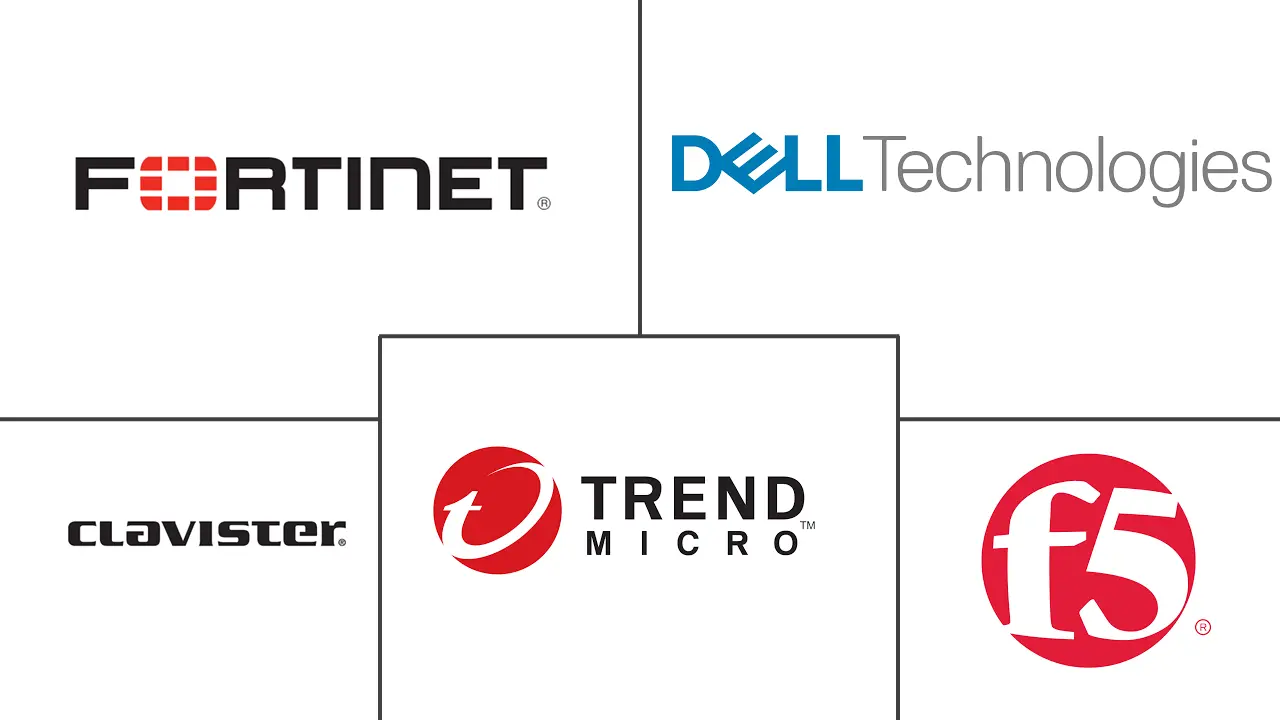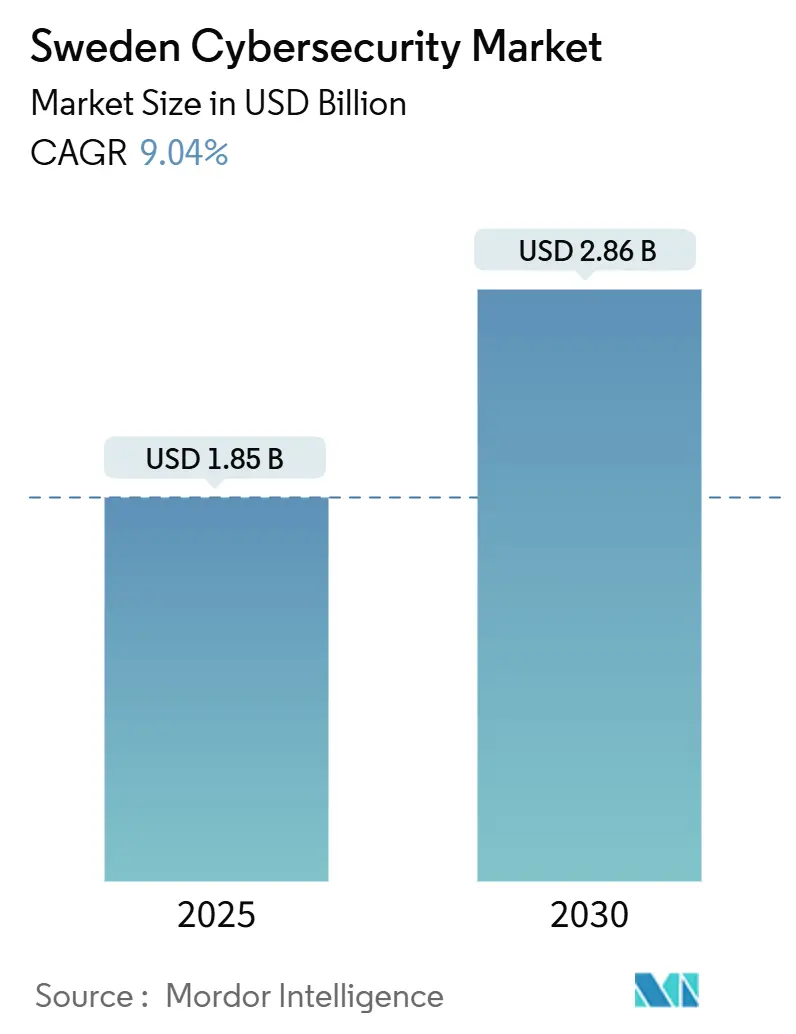
Sweden Cybersecurity Market Analysis by Mordor Intelligence
The Sweden cybersecurity market is valued at USD 1.85 billion in 2025 and is projected to reach USD 2.86 billion by 2030, advancing at a 9.04% CAGR. The up-trend reflects a fusion of heightened regulatory pressure, fast-paced cloud migration, and the geopolitical shift triggered by Stockholm’s NATO accession, which has increased nation-state attacks on critical infrastructure. Identity-centric protection anchored in BankID, accelerated adoption of zero-trust frameworks, and rising demand for managed detection and response are shaping enterprise procurement. At the same time, the looming enforcement of the EU NIS2 directive is forcing even small firms to formalize cyber-risk governance, widening the addressable base for compliance automation tools. Managed security providers able to monetize Sweden’s renewables-powered cloud footprint and the country’s digital-identity ubiquity stand to capture out-sized growth as organizations offset talent shortages with outsourced operations.
Key Report Takeaways
- By offering, solutions captured 67.2% revenue in 2024, while services are poised for the fastest 11.2% CAGR to 2030.
- By deployment, cloud held 65.4% of Sweden cybersecurity market share in 2024 and is expanding at an 11.7% CAGR through 2030.
- By organization size, large enterprises commanded 72.3% of the Sweden cybersecurity market size in 2024; SMEs record the highest 10.2% CAGR to 2030.
- By end user, BFSI led with 29.1% of Sweden cybersecurity market size in 2024; healthcare shows the quickest 9.6% CAGR to 2030.
Sweden Cybersecurity Market Trends and Insights
Drivers Impact Analysis
| Driver | (~) % Impact on CAGR Forecast | Geographic Relevance | Impact Timeline |
|---|---|---|---|
| Intensifying cloud-migration among Swedish enterprises | +2.10% | National, concentrated in Stockholm, Gothenburg, Malmö | Medium term (2-4 years) |
| Surge in ransomware-as-a-service (RaaS) attacks on critical infrastructure | +1.80% | National, with spillover effects to Nordic region | Short term (≤ 2 years) |
| EU NIS2 directive accelerating budget allocations | +1.50% | National, aligned with EU-wide implementation | Medium term (2-4 years) |
| Boom in "Bank-ID" usage driving identity-centric security demand | +1.20% | National, with Nordic expansion potential | Long term (≥ 4 years) |
| Swedish micro-SME cyber-insurance premium rebates | +0.80% | National, rural and urban SME clusters | Medium term (2-4 years) |
| Energy-grid OT-security pilot programs funded by Svenska kraftnät | +0.60% | National critical infrastructure, Nordic collaboration | Long term (≥ 4 years) |
| Source: Mordor Intelligence | |||
Intensifying Cloud Migration Among Swedish Enterprises
Cloud-first adoption now underpins 65.4% of total deployments, and sustained 11.7% annual growth is enlarging the Sweden cybersecurity market as enterprises abandon perimeter-centric controls in favor of zero-trust frameworks. Investments such as Brookfield Asset Management’s SEK 95 billion (USD 9.95 billion) AI and data-center build-out in Strängnäs signal long-run demand for sovereign cloud security that aligns with both GDPR and NIS2 requirements. Hybrid and multi-cloud strategies documented by Visma show security overtaking cost as the decisive factor in provider selection, prompting vendors to bundle posture-management, workload-protection, and identity-governance capabilities into single platforms.[1]Visma, “2025 Cloud Computing Trends in Sweden,” visma.com BankID compatibility, data-residency assurances, and renewable-power credentials have become procurement prerequisites, positioning Swedish suppliers with Nordic regulatory fluency for premium pricing.
Surge in Ransomware-as-a-Service Attacks on Critical Infrastructure
Nationwide ransomware incidents have risen 183% year-on-year, punctuated by the Tietoevry breach that disrupted government agencies and supply chains. The Swedish Civil Contingencies Agency estimates direct cyber-losses above SEK 30 billion (USD 3.15 billion), catalyzing urgent outlays on immutable backups, air-gapped storage, and managed detection and response. Svenska kraftnät’s expanded OT-monitoring program following geomagnetic grid disturbances underscores the new priority on operational-technology security.[2]Svenska kraftnät, “Operational Technology Security Program,” svk.seNordic Defender’s triple-digit revenue spike mirrors demand for 24/7 security operations capable of handling industrial protocols and cross-border threat intelligence.
EU NIS2 Directive Accelerating Budget Allocations
Sweden’s March 2024 guideline extends NIS2 coverage to 18 sectors and institutes fines up to EUR 10 million (USD 11.77 million) or 2% of global turnover, creating a compliance imperative for roughly 3,000 additional entities. Boards are allocating incremental budgets to vendor-risk management, automated incident reporting, and governance platforms able to integrate with existing tooling. Holm Security’s EUR 4 million (USD 4.71 million) capital raise dedicated to next-generation vulnerability management illustrates investment flow toward solutions engineered around real-time monitoring, auditable controls, and Nordic data-sovereignty needs.[3]Holm Security, “Next-Gen Vulnerability Management Funding,” holmsecurity.com Continuous-assurance functionality is becoming a standard RFP requirement across public and private sectors.
Boom in BankID Usage Driving Identity-Centric Security Demand
BankID processed 7.6 billion authentications in 2024, reaching 99.9% penetration among Swedish adults and cementing identity as the primary security control plane. Healthcare platforms such as Curoflow deploy BankID for safe patient onboarding, and cross-border eIDAS recognition is expanding the reach of Sweden’s digital-ID standard. While traditional authentication vendors struggle to differentiate, niche identity-access-management players offering BankID integration, risk-based authentication, and privacy-preserving alternatives are commanding premium valuations. Dependency concerns are also fueling interest in decentralized identity proofs promoted by start-ups like Truid, foreshadowing a diversified identity ecosystem.
Restraints Impact Analysis
| Restraint | (~) % Impact on CAGR Forecast | Geographic Relevance | Impact Timeline |
|---|---|---|---|
| Persistent talent drain to pan-Nordic SOC hubs | -1.40% | National, concentrated in Stockholm tech corridor | Medium term (2-4 years) |
| High legacy-system technical debt in public sector | -1.10% | National, municipal and regional government focus | Long term (≥ 4 years) |
| Delayed 5G security certification framework | -0.70% | National, with Nordic coordination dependencies | Medium term (2-4 years) |
| Fragmented municipal procurement cycles | -0.50% | National, 290 municipalities with varying capabilities | Long term (≥ 4 years) |
| Source: Mordor Intelligence | |||
Persistent Talent Drain to Pan-Nordic SOC Hubs
Sweden needs 18,000 additional tech specialists annually through 2028, but rising Nordic wage competition is siphoning cybersecurity talent to regional SOC hubs where salaries surpass EUR 6,000 (USD 7061.32) per month. Organizations compensate by outsourcing detection and response, escalating demand for managed services yet limiting in-house capability building. Government incentives—including income-tax relief and updated work-permit rules—may ease pressure, though SMEs remain vulnerable to cost-driven brain drain, reinforcing their dependence on automated security suites.
High Legacy-System Technical Debt in Public Sector
The SEK 4 million (USD O.42 million) fine tied to Stockholm’s school-platform breach exposed archaic municipal systems ill-prepared for modern threat landscapes. Budget-limited agencies face costly custom integrations to overlay new controls on out-dated infrastructure, extending project timelines and burdening procurement cycles. National Program 2032 seeks to consolidate workloads into secure state data centers, but multi-cycle funding needs will prolong exposure, especially in smaller municipalities that lag resource-rich peers.
Segment Analysis
By Offering: Services Surge Amid Solutions Dominance
Solutions contributed 67.2% revenue in 2024, anchored by identity and access management that must embed BankID hooks and by accelerating demand for cloud-native controls. Cloud security is the fastest-moving sub-category, reflecting Sweden’s pivot toward distributed workloads and European compliance mandates. The Sweden cybersecurity market size for solutions is on course for sustained mid-single-digit expansion as vendors integrate zero-trust, workload protection, and automated policy orchestration.
Services deliver the growth thrust, advancing at 11.2% CAGR as organizations counter talent shortages by shifting to outcome-based engagements. Managed security now covers SOC operations, threat hunting, and compliance documentation tuned for Swedish and EU statutes. The Sweden cybersecurity market share attributed to managed services will expand as vendors like Allurity consolidate boutiques into end-to-end platforms that fuse local regulatory know-how with AI-enhanced analytics.
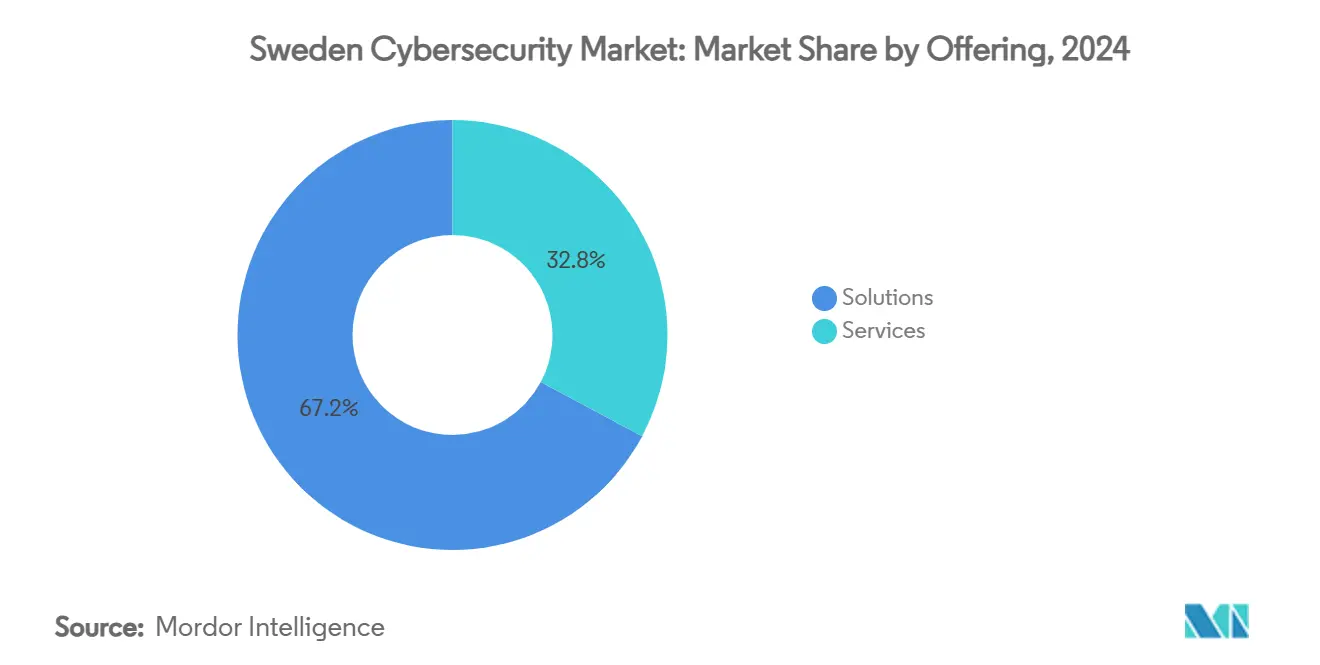
By Deployment Mode: Cloud Acceleration Transforms Security Architecture
Cloud deployments owned 65.4% revenue in 2024 and will climb faster than on-premise as Brookfield’s hyperscale build-outs and the country’s renewable grid make Sweden an attractive data-residency zone. Future Sweden cybersecurity market size gains will be concentrated in workload-protection platforms, cloud-native application protection, and identity-federation layers that weave BankID credentials into enterprise Single-Sign-On pipelines.
On-premise persists in energy, defense, and selective public workloads, where air-gaps and sovereign-control imperatives outweigh scalability. Hybrid computing creates integration challenges, spurring orders for secure connectivity gateways, tokenization services, and encrypted data lakes. Vendors able to demonstrate seamless policy coherence across SaaS, IaaS, and legacy clusters will differentiate.
By Organization Size: SME Acceleration Challenges Enterprise Dominance
Large enterprises generated 72.3% of 2024 revenue, yet SMEs post the briskest 10.2% CAGR as insurance rebates and SaaS price points reduce adoption friction. Regulatory spill-over from NIS2 obliges even sub-50-employee firms to implement baseline controls, swelling demand for automated compliance kits. The Sweden cybersecurity market continues to bifurcate: enterprise buyers emphasize threat-intelligence fusion and bespoke SOC integrations, while SMEs gravitate to plug-and-play suites bundled with risk-transfer coverage.
Talent scarcity deepens this divergence. Enterprises secure scarce analysts; SMEs lean on managed services. New vendor packaging—such as per-user subscription tiers wrapping endpoint, email, and backup defenses—speeds SME onboarding. Government efforts to attract foreign expertise and streamline work permits should moderately ease capacity constraints for both cohorts, yet wage inflation will likely sustain outsourcing momentum.
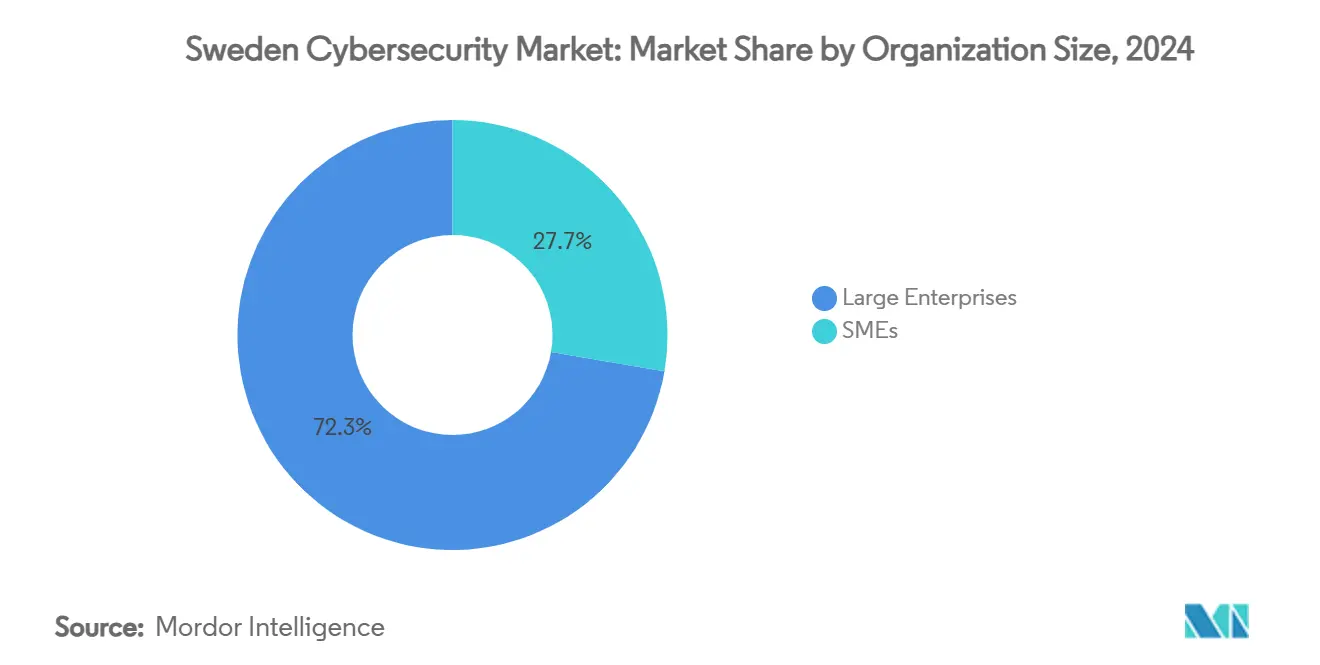
By End User: Healthcare Surge Challenges BFSI Leadership
BFSI retained 29.1% revenue in 2024, compelled by stringent data-protection rules and DDoS barrages targeting Sweden’s high-digital-banking penetration. Tier-1 banks invest in behavioral analytics, secure open-banking APIs, and high-capacity scrubbing centers. However, healthcare is racing ahead at 9.6% CAGR, propelled by ransomware attacks on patient records and the expansion of the 1177 e-health platform that authenticates all sessions via BankID.
Energy and utilities segment growth is tied to OT-security pilots co-funded by Svenska kraftnät, while manufacturing accelerates spending on secure industrial protocols as Industry 4.0 gains velocity. Vendors offering OT-native threat models and low-latency anomaly detection see rising interest as smart-factory roll-outs advance. Retail and telecom clients broaden investments in API security and fraud analytics to mitigate omnichannel risks.
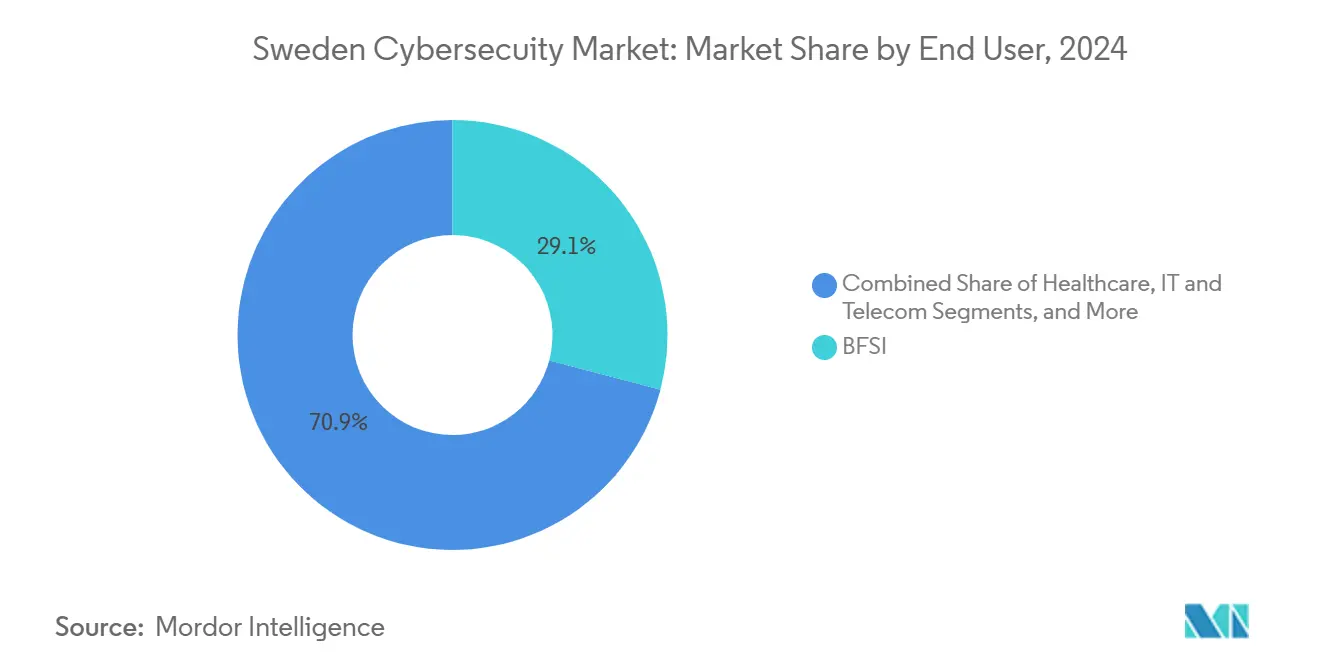
Note: Segment shares of all individual segments available upon report purchase
Geography Analysis
Investment remains concentrated in the Stockholm–Gothenburg–Malmö axis that accounts for 65% of national cybersecurity outlays. The region’s dense cluster of banks, tech start-ups, and public agencies fosters a deep partner ecosystem and ready venture capital, illustrated by Detectify’s majority sale to Insight Partners aimed at enlarging application-security reach. Universities and research centers funnel graduates into local SOCs, yet steep competition contributes to talent churn.
Northern Sweden is emerging as a secondary node. Hyperscale data-center developments leverage abundant hydroelectric power, pulling security spending into Norrbotten and Västmanland. Brookfield’s AI capacity expansion will create sustained demand for workload isolation, sovereign-key management, and continuous audit services. Meanwhile, cross-municipal cooperatives such as eSamverka coordinate procurement frameworks to aggregate volume and standardize controls, giving mid-sized vendors access to rural markets.
Public-sector modernization programs radiate spending into smaller municipalities. Program 2032’s secure-state-datacenter roadmap drives contracts for encryption, privilege-access gateways, and SIEM consolidation. The fragmentation of 290 municipal procurement pathways still hampers rollout speed, but harmonized NIS2 enforcement should gradually align requirements, letting suppliers scale packaged offerings across local authorities.
Competitive Landscape
The Sweden cybersecurity market features moderate concentration: domestic champions Clavister, Truesec, and Advenica hold strong positions in firewall, incident-response, and crypto-module niches, while global majors such as Cisco, Fortinet, Palo Alto Networks, and Microsoft dominate next-gen network and cloud workloads. Strategic moves underscore consolidation: Allurity’s Onevinn purchase augments AI-aligned managed services, and EQT’s stake in Acronis gives the Swedish private-equity leader a global data-protection footprint.
Technology differentiation hinges on AI-powered automation, contextualized threat intelligence, and compliance orchestration bespoke to Nordic legal frameworks. Holm Security’s funding round accelerates continuous vulnerability management with local-language dashboards and preset NIS2 control libraries. Vendors unable to integrate BankID or prove Swedish data-sovereignty face limited traction.
Talent scarcity shapes strategy: vendors strengthen university alliances, sponsor reskilling initiatives, and embed artificial-intelligence features that reduce analyst workload. Global cloud providers are partnering with local MSSPs to translate generic controls into Sweden-specific baselines, mitigating the cultural and regulatory gap. Opportunities remain open in OT security for energy grids, SMB-tier MDR, and municipal compliance automation, where localized content and Swedish-language support are decisive.
Sweden Cybersecurity Industry Leaders
-
Clavister AB
-
Trend Micro Inc.
-
F5 Inc.
-
Fortinet Inc.
-
Dell Technologies Inc.
- *Disclaimer: Major Players sorted in no particular order
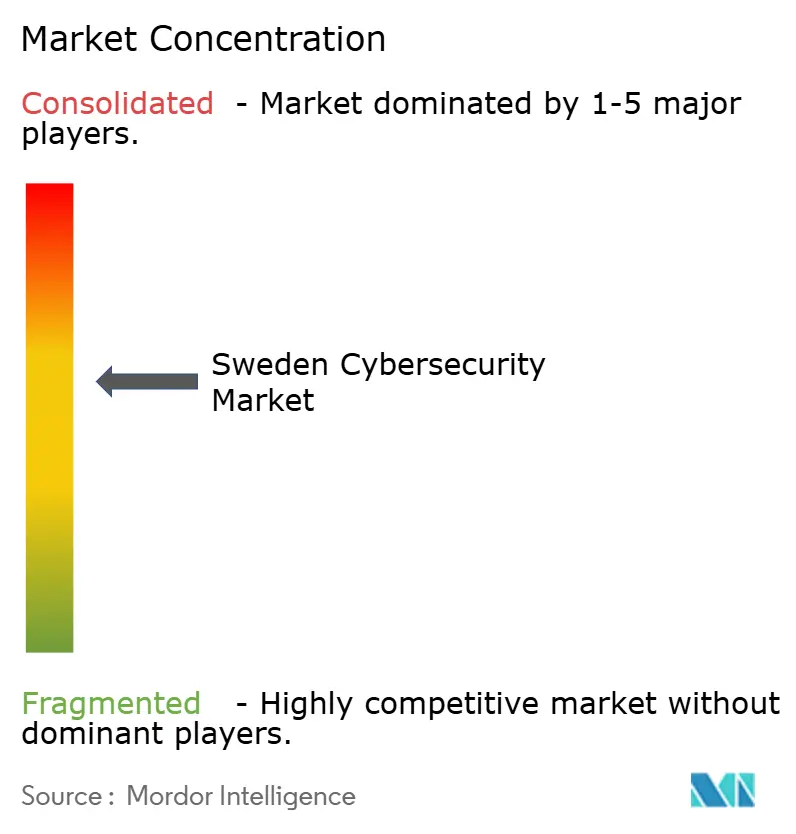
Recent Industry Developments
- June 2025: Brookfield Asset Management confirmed a SEK 95 billion (USD 9.95 billion) AI-center project in Strängnäs, doubling national hyperscale capacity and elevating demand for cloud-native defenses.
- April 2025: Allurity acquired Göteborg-based Onevinn to deepen Microsoft-aligned MDR capabilities and expand Nordic SOC coverage.
- February 2025: F-Secure Corporation posted EUR 146.3 million (USD 170.17 million) 2024 revenue, up 12.2%, and will redirect EUR 4 million (USD 4.65 million) in cost savings to growth investments.
- January 2025: Truesec released its 2025 Threat Intelligence Report outlining rising SME ransomware and AI-enabled cybercrime.
Sweden Cybersecurity Market Report Scope
Cybersecurity solutions enable an organization to monitor, detect, report, and counter cyber threats, which are internet-based attempts to damage or disrupt information systems and hack critical information using spyware, malware, and phishing to maintain data confidentiality. The study tracks the market based on the spending by the end-users on cybersecurity solutions, as listed in the scope of the study.
The Sweden cyber security market is segmented by offerings (solutions [application security, cloud security, data security, identity access management, infrastructure protection, integrated risk management, network security, end-point security, and other solution types] and services [professional services and managed services]), by deployment (On-premise, and cloud), by organization size (SMEs, large enterprises), by end-user vertical (BFSI, healthcare, IT and telecom, industrial and defense, retail, energy and utilities, manufacturing, and other end-user industries). The market sizes and forecasts are provided in terms of value in (USD) for all the above segments.
| Solutions | Application Security |
| Cloud Security | |
| Data Security | |
| Identity and Access Management | |
| Infrastructure Protection | |
| Integrated Risk Management | |
| Network Security Equipment | |
| Endpoint Security | |
| Other Solutions | |
| Services | Professional Services |
| Managed Services |
| Cloud |
| On-Premise |
| SMEs |
| Large Enterprises |
| BFSI |
| Healthcare |
| IT and Telecom |
| Industrial and Defense |
| Retail |
| Energy and Utilities |
| Manufacturing |
| Others |
| By Offering | Solutions | Application Security |
| Cloud Security | ||
| Data Security | ||
| Identity and Access Management | ||
| Infrastructure Protection | ||
| Integrated Risk Management | ||
| Network Security Equipment | ||
| Endpoint Security | ||
| Other Solutions | ||
| Services | Professional Services | |
| Managed Services | ||
| By Deployment Mode | Cloud | |
| On-Premise | ||
| By Organization Size | SMEs | |
| Large Enterprises | ||
| By End User | BFSI | |
| Healthcare | ||
| IT and Telecom | ||
| Industrial and Defense | ||
| Retail | ||
| Energy and Utilities | ||
| Manufacturing | ||
| Others | ||
Key Questions Answered in the Report
What is the current size of the Sweden cybersecurity market?
The market is worth USD 1.85 billion in 2025 and is forecast to reach USD 2.86 billion by 2030.
Which segment is growing fastest within the Sweden cybersecurity market?
Managed services are recording an 11.2% CAGR as firms offset talent shortages with outsourced security operations.
Why is healthcare cybersecurity investment accelerating in Sweden?
Increasing ransomware attacks on patient data and the nationwide 1177 e-health platform drive a 9.6% CAGR for healthcare security spend.
What role does BankID play in Sweden’s cybersecurity landscape
BankID processes nearly every adult’s digital interactions, making identity-centric security the linchpin of most Swedish deployments and shaping vendor integration roadmaps.
Page last updated on:
